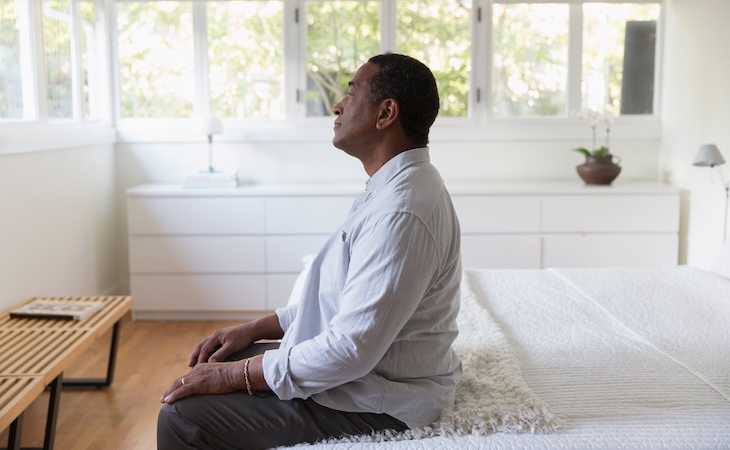Although we all have our preferred sleeping position, each has its benefits and downsides. In fact, some sleep positions can exacerbate back pain—or even cause it—while others can help prevent sleep-disrupting conditions like snoring and acid reflux.
It’s important to know the pros and cons of each sleep position so you can make whatever adjustments may be necessary to get your best night’s sleep.
We’ve broken down the pros and cons of back sleeping, side sleeping, and stomach sleeping below.
Back sleeping
The National Sleep Foundation considers back sleeping, with your arms at your sides, the ideal position. That’s because it keeps your head and spine in a neutral alignment, eliminating the pressure that contributes to aches and pains and allowing back muscles to relax. (Learn more about the benefits of back sleeping.)
The gold standard is back sleep without (or with only minimal) pillows, as this leaves your neck in a neutral position as well. Back sleeping is especially good for people with back pain or tightness, though it’s not so good for those prone to snoring or those who have sleep apnea.
Pros of back sleeping
- Head, neck, and spine remain in a natural, neutral position for less chance of back pain
- Alleviates acid reflux by keeping your head above your esophagus to prevent stomach acid from coming up your digestive tract (if you elevate your head with a pillow or adjustable base)
- Helps prevent wrinkles and acne by keeping your face off the pillow, free of pressure, and out of contact with bacteria on your pillowcase
Cons of back sleeping
- May perpetuate snoring and/or sleep apnea because gravity causes the tongue or loose tissue in the throat to collapse and block the airway
Side sleeping
By far the most common sleep position, side sleeping is also one of the best positions for your health. It’s particularly good for anyone who snores or has lower back pain. It can help reduce acid reflux and prevent back and neck pain by keeping your spine naturally elongated. Side sleeping helps those with sleep apnea and/or persistent snoring by reducing obstruction of the airway.
The ideal side-sleeping position is on the left side. Doctors actually encourage pregnant women to sleep on their left side because it improves blood circulation for both mother and fetus. It’s important to note that sleeping on your side in a fetal position—knees drawn up to your face—doesn’t offer the same benefits because it puts your head and spine out of alignment. (Here are our best sleep tips for side sleepers.)
Pros of side sleeping
- Eases heartburn and acid reflux
- Relieves breathing difficulties that lead to snoring
- Diminishes sleep apnea symptoms
- Improves blood flow because of reduced pressure on the vena cavae, the arteries moving blood to and from the heart
Cons of side sleeping
- Puts pressure on your hips, shoulders, and neck, which in turn puts pressure on your spine
- The side-lying fetal position can cause back and neck pain
- Cuts off circulation in the arm resting under the body during side sleep because of capillary collapse from weight on the arm for an extended time
Stomach sleeping
Only an estimated 7% of Americans sleep on their stomachs, for good reason. Sleeping on your stomach makes it hard for the spine to stay in a neutral position. Add spinal misalignment to the need to keep your head turned to the side, and you have a recipe for chronic back and neck pain.
On the plus side, though, stomach sleeping is good for people who snore because the tongue doesn’t “fall” as it does in back sleeping. This can relieve the breathing difficulty that leads to snoring.
Overall, the best thing you can do if you’re a stomach sleeper is to use pillows to train your body into side or back sleeping. Simply put, stomach sleeping has too many negative consequences to make it a long-term habit.
Pros of stomach sleeping
- Lets you breathe more easily
- Diminishes sleep apnea symptoms
Cons of stomach sleeping
- Aches and pains because stomach sleeping strains the back, neck, and joints due to keeping the head and neck twisted to one side for an extended time
- May perpetuate the discomfort of acid reflux
- Feeling hot is a common complaint of stomach sleepers
- Puts pressure on certain organs and can contribute to premature sagging of your breasts by holding them in an unnatural position for an extended time
How to find the best mattress for your sleeping position
Regardless of which sleeping position you choose to snooze in, it’s important to find a mattress that will accentuate the pros while minimizing the cons. Read our guides to matching your mattress with your sleep position:
- The Best Mattress for Back Sleepers
- The Best Mattress for Side Sleepers
- The Best Mattress for Stomach Sleepers







